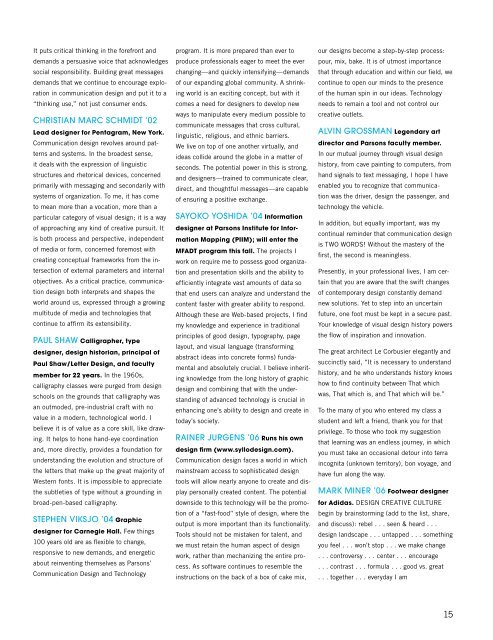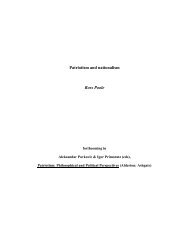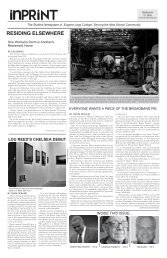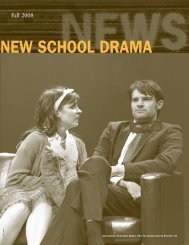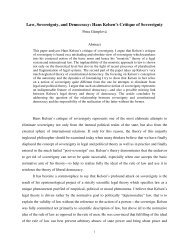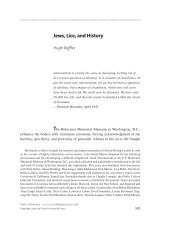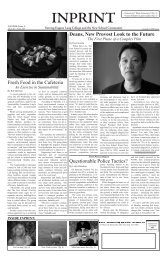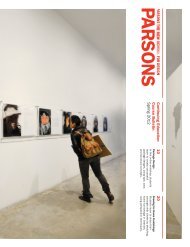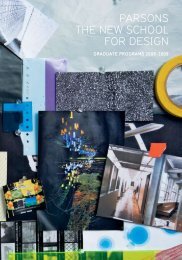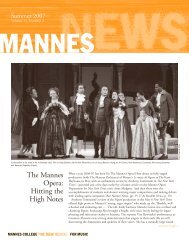re:D Fall 2007 (PDF) - The New School
re:D Fall 2007 (PDF) - The New School
re:D Fall 2007 (PDF) - The New School
You also want an ePaper? Increase the reach of your titles
YUMPU automatically turns print PDFs into web optimized ePapers that Google loves.
It puts critical thinking in the fo<strong>re</strong>front and<br />
demands a persuasive voice that acknowledges<br />
social <strong>re</strong>sponsibility. Building g<strong>re</strong>at messages<br />
demands that we continue to encourage exploration<br />
in communication design and put it to a<br />
“thinking use,” not just consumer ends.<br />
CHRISTIAN MARC SCHMIDT ’02<br />
Lead designer for Pentagram, <strong>New</strong> York.<br />
Communication design <strong>re</strong>volves around patterns<br />
and systems. In the broadest sense,<br />
it deals with the exp<strong>re</strong>ssion of linguistic<br />
structu<strong>re</strong>s and rhetorical devices, concerned<br />
primarily with messaging and secondarily with<br />
systems of organization. To me, it has come<br />
to mean mo<strong>re</strong> than a vocation, mo<strong>re</strong> than a<br />
particular category of visual design; it is a way<br />
of approaching any kind of c<strong>re</strong>ative pursuit. It<br />
is both process and perspective, independent<br />
of media or form, concerned fo<strong>re</strong>most with<br />
c<strong>re</strong>ating conceptual frameworks from the intersection<br />
of external parameters and internal<br />
objectives. As a critical practice, communication<br />
design both interp<strong>re</strong>ts and shapes the<br />
world around us, exp<strong>re</strong>ssed through a growing<br />
multitude of media and technologies that<br />
continue to affirm its extensibility.<br />
PAUL SHAW Calligrapher, type<br />
designer, design historian, principal of<br />
Paul Shaw/Letter Design, and faculty<br />
member for 22 years. In the 1960s,<br />
calligraphy classes we<strong>re</strong> purged from design<br />
schools on the grounds that calligraphy was<br />
an outmoded, p<strong>re</strong>-industrial craft with no<br />
value in a modern, technological world. I<br />
believe it is of value as a co<strong>re</strong> skill, like drawing.<br />
It helps to hone hand-eye coordination<br />
and, mo<strong>re</strong> di<strong>re</strong>ctly, provides a foundation for<br />
understanding the evolution and structu<strong>re</strong> of<br />
the letters that make up the g<strong>re</strong>at majority of<br />
Western fonts. It is impossible to app<strong>re</strong>ciate<br />
the subtleties of type without a grounding in<br />
broad-pen-based calligraphy.<br />
STEPHEN VIKSJO ’04 Graphic<br />
designer for Carnegie Hall. Few things<br />
100 years old a<strong>re</strong> as flexible to change,<br />
<strong>re</strong>sponsive to new demands, and energetic<br />
about <strong>re</strong>inventing themselves as Parsons’<br />
Communication Design and Technology<br />
program. It is mo<strong>re</strong> p<strong>re</strong>pa<strong>re</strong>d than ever to<br />
produce professionals eager to meet the ever<br />
changing—and quickly intensifying—demands<br />
of our expanding global community. A shrinking<br />
world is an exciting concept, but with it<br />
comes a need for designers to develop new<br />
ways to manipulate every medium possible to<br />
communicate messages that cross cultural,<br />
linguistic, <strong>re</strong>ligious, and ethnic barriers.<br />
We live on top of one another virtually, and<br />
ideas collide around the globe in a matter of<br />
seconds. <strong>The</strong> potential power in this is strong,<br />
and designers—trained to communicate clear,<br />
di<strong>re</strong>ct, and thoughtful messages—a<strong>re</strong> capable<br />
of ensuring a positive exchange.<br />
SAYOKO YOSHIDA ’04 Information<br />
designer at Parsons Institute for Information<br />
Mapping (PIIM); will enter the<br />
MFADT program this fall. <strong>The</strong> projects I<br />
work on <strong>re</strong>qui<strong>re</strong> me to possess good organization<br />
and p<strong>re</strong>sentation skills and the ability to<br />
efficiently integrate vast amounts of data so<br />
that end users can analyze and understand the<br />
content faster with g<strong>re</strong>ater ability to <strong>re</strong>spond.<br />
Although these a<strong>re</strong> Web-based projects, I find<br />
my knowledge and experience in traditional<br />
principles of good design, typography, page<br />
layout, and visual language (transforming<br />
abstract ideas into conc<strong>re</strong>te forms) fundamental<br />
and absolutely crucial. I believe inheriting<br />
knowledge from the long history of graphic<br />
design and combining that with the understanding<br />
of advanced technology is crucial in<br />
enhancing one’s ability to design and c<strong>re</strong>ate in<br />
today’s society.<br />
RAINER JURGENS ’06 Runs his own<br />
design firm (www.syllodesign.com).<br />
Communication design faces a world in which<br />
mainst<strong>re</strong>am access to sophisticated design<br />
tools will allow nearly anyone to c<strong>re</strong>ate and display<br />
personally c<strong>re</strong>ated content. <strong>The</strong> potential<br />
downside to this technology will be the promotion<br />
of a “fast-food” style of design, whe<strong>re</strong> the<br />
output is mo<strong>re</strong> important than its functionality.<br />
Tools should not be mistaken for talent, and<br />
we must <strong>re</strong>tain the human aspect of design<br />
work, rather than mechanizing the enti<strong>re</strong> process.<br />
As softwa<strong>re</strong> continues to <strong>re</strong>semble the<br />
instructions on the back of a box of cake mix,<br />
our designs become a step-by-step process:<br />
pour, mix, bake. It is of utmost importance<br />
that through education and within our field, we<br />
continue to open our minds to the p<strong>re</strong>sence<br />
of the human spin in our ideas. Technology<br />
needs to <strong>re</strong>main a tool and not control our<br />
c<strong>re</strong>ative outlets.<br />
ALVIN GROSSMAN Legendary art<br />
di<strong>re</strong>ctor and Parsons faculty member.<br />
In our mutual journey through visual design<br />
history, from cave painting to computers, from<br />
hand signals to text messaging, I hope I have<br />
enabled you to <strong>re</strong>cognize that communication<br />
was the driver, design the passenger, and<br />
technology the vehicle.<br />
In addition, but equally important, was my<br />
continual <strong>re</strong>minder that communication design<br />
is TWO WORDS! Without the mastery of the<br />
first, the second is meaningless.<br />
P<strong>re</strong>sently, in your professional lives, I am certain<br />
that you a<strong>re</strong> awa<strong>re</strong> that the swift changes<br />
of contemporary design constantly demand<br />
new solutions. Yet to step into an uncertain<br />
futu<strong>re</strong>, one foot must be kept in a secu<strong>re</strong> past.<br />
Your knowledge of visual design history powers<br />
the flow of inspiration and innovation.<br />
<strong>The</strong> g<strong>re</strong>at architect Le Corbusier elegantly and<br />
succinctly said, “It is necessary to understand<br />
history, and he who understands history knows<br />
how to find continuity between That which<br />
was, That which is, and That which will be.”<br />
To the many of you who ente<strong>re</strong>d my class a<br />
student and left a friend, thank you for that<br />
privilege. To those who took my suggestion<br />
that learning was an endless journey, in which<br />
you must take an occasional detour into terra<br />
incognita (unknown territory), bon voyage, and<br />
have fun along the way.<br />
MARK MINER ’06 Footwear designer<br />
for Adidas. DESIGN CREATIVE CULTURE<br />
begin by brainstorming (add to the list, sha<strong>re</strong>,<br />
and discuss): <strong>re</strong>bel . . . seen & heard . . .<br />
design landscape . . . untapped . . . something<br />
you feel . . . won’t stop . . . we make change<br />
. . . controversy . . . center . . . encourage<br />
. . . contrast . . . formula . . . good vs. g<strong>re</strong>at<br />
. . . together . . . everyday I am<br />
15


